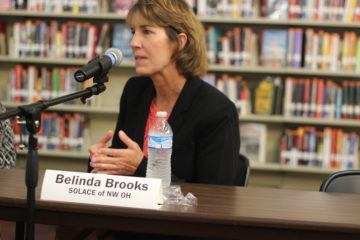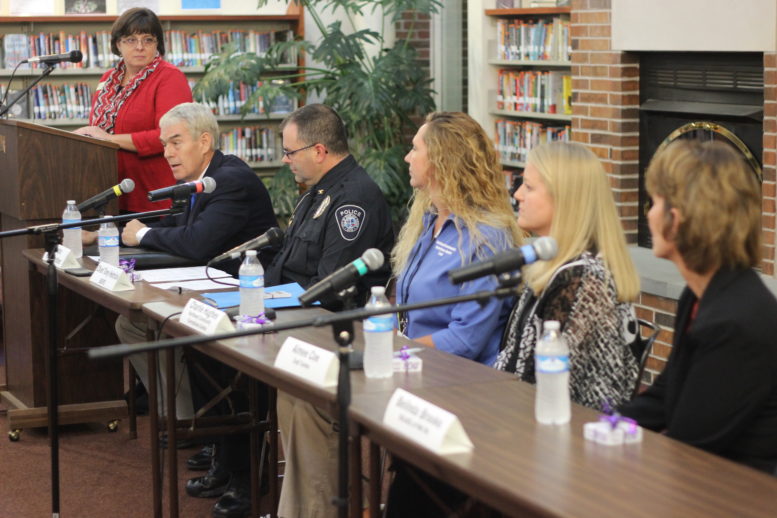By DAVID DUPONT
BG Independent News
State Senator Randy Gardner (R-Bowling Green) was understating matters when he said last Wednesday that the opioid epidemic has “a lot of people talking.”
He said this just as a “BG Talks: Heroin and Opioids in Bowling Green and Wood County” was just getting underway at the Wood County District Public library.
The moderator for the panel discussion Kristin Wetzel, began the session painting a bleak picture of the crisis nationwide, 948,000 overdoses in 2016, and 13,219 fatalities. These numbers are enough to get anyone talking.
On Thursday afternoon, State Rep. Robert Sprague (R-Findlay) convened a roundtable of state politicians, law enforcement officials, and treatment experts to discuss the crisis. This Wednesday, Sept. 20, the Bowling Green Chamber of Commerce will host a seminar on the epidemic. See details here.

Belinda Brooks tells the story of her daughter’s addiction.
Both Gardner and Sprague noted that the legislature has done more than talk about the issue. In a budget year when the legislature faced tight finances, it budgeted an increase of $178 million more to combat the epidemic.
Still, Gardner said, frustrations over the progress remain.
Eight years ago, Belinda Brooks, of Solace of Northwest Ohio, got “a crash course” in the issue.
Her then 18-year-old daughter became hooked on opioids after a serious ATV accident. She was prescribed Percocet and Vicodin. Having some self-esteem problems, the daughter suddenly realized “she was the life of the party when she took them.”
That led to heroin. And at 19 she got pregnant, and even that wasn’t enough to get her to kick the habit.
Charlie Hughes, of the Northwest Community Corrections Center, said of addicts “their brain has convinced them they need (the opioid) to survive.”
“My life changed,” Brooks said.
Afraid she would fall apart, she reached out to other parents in her situation, and formed the support group Solace.
“I made many mistakes,” Brooks admitted. “I hid her addiction. I thought I could fix her. … When it comes to addiction all your parenting skills go out the window. You need to get them into treatment.”
And that means being tough.
“We encourage people not to enable,” said Aimee Coe, of the Zepf Center.
That means being vigilant in spotting the symptoms. Brooks said she was confused why her daughter carried so many long handled cotton swabs. They are used to filter heroin.
Track marks are a sure sign, but Brooks noted, heroin can also be snorted. She noticed her daughter nodding off, and then the thefts happened, minor at first, then larger items such as a TV.
Families aren’t the only victims. Bowling Green Police Chief Tony Hetrick said “it’s hard to keep up with the thefts.” It’s gotten so bad at big box stores they they’ve stopped reporting them. “It’s a real issue.”
Brooks said all this affects not just the addict, but the extended family. Many grandparents are having to take in grandchildren. That’s putting a financial burden on two generations.
“It’s easy to bail them out of these circumstances,” Coe said. “But you just need to let them experience the concessions and it will bring them to treatment earlier.”
Hughes said: “They’re often angry at first. In time, they’ll see the benefits.”
Coe said there’s a need for more recovery housing where they can go to receive peer support “to help them navigate the early days of sobriety when the threat of relapse is most prevalent.”
Coe said they also must deal with other trauma. Addicts are more likely to be victims of violence, including rape.
Brooks said her daughter is now sober, but the support group continues. The members live with the fear of relapse. “It gets better,” she said. “But it’s never the same.”
Hetrick said he treats every overdose as a “criminal investigation.”
The target isn’t necessarily the addict, but the drug pusher. State law allows addicts who admit their offense to avoid prosecution if they undergo treatment.
Once police start the investigation, they can seize a cellphone that may provide crucial information on the drug network.
Bowling Green “is not a source community for heroin,” Hetrick said. Instead addicts travel to Findlay and Toledo to find the drug.”
Hetrick said he would like to mandate that medical professionals report overdoses just as they report other types of injuries.
He repeated that request the next day at the legislative roundtable. There a dozen or so representatives from various programs gave brief descriptions of the programs they offer.
Sprague said he wanted to hear ideas on that can be done to address the epidemic.
That included a discussion of the importance of treating pregnant addicts. Many obstetrical practices do not want to see such patients, but it is essential for both the woman and the fetus for care to begin as early as possible. Brain damage that occurs in the womb is irreversible.
The woman can take Suboxone, which helps keep the symptoms of withdrawal at bay. The drug, however, has a different effect on different individuals.
Jon Sprague, who hosted the session in the Bureau of Criminal Investigation lab on the Bowling Green State University campus, talked about an online education effort modeled on Wisconsin’s Dose of Reality program. This would include an app to help people find treatment options within their communities.
Kyle Clark, the director of prevention for the Wood County Educational Service Center, talked about the data that’s been collected in local schools for 14 years. That data can be used as a benchmark to look at the situation statewide, he said.
Sprague noted that any solutions implemented “must be evidence-based.”
On Wednesday night at the library, Gardner said people should not get discouraged by all the numbers. “We could be at the peak of the challenge we face,” he said. People should concentrate on continuing to address the problem.
In fact, he noted, some numbers presented by Hetrick pointed to a turn around.
Hetrick reported that in 2016 his department handled 22 overdose cases and four fatalities. This year there’s been a lower rate with 12 overdoses and one fatality.





